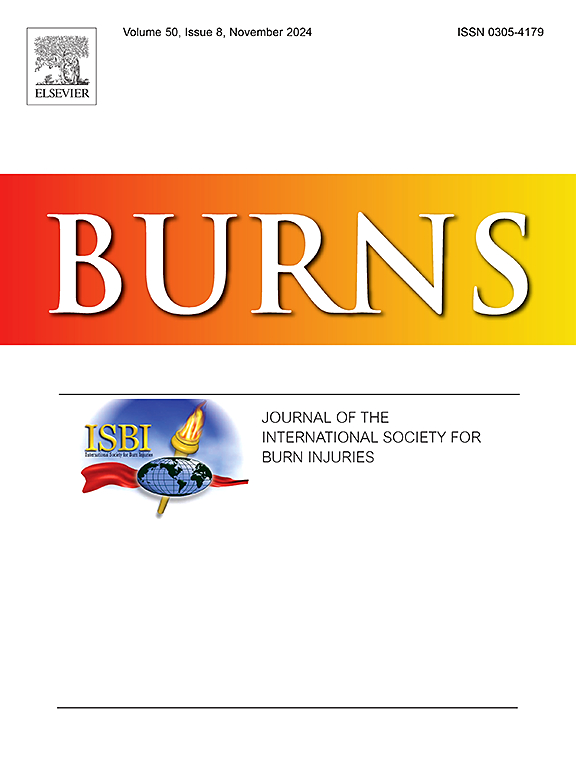Endothelial dysfunction in areas of unburned skin in a burn injury model
IF 2.9
3区 医学
Q2 CRITICAL CARE MEDICINE
引用次数: 0
Abstract
Introduction
Burn shock is mediated by a complex inflammatory response leading to endothelial cell dysfunction (EnD) and increased vascular permeability in large total body surface area (TBSA) injuries. Smaller TBSA burns do not induce systemic EnD. Previous studies in animal models have examined systemic markers of endothelial cell dysfunction following thermal injury and have aimed to characterize this dysfunction in various end organs. However, there is limited literature investigating EnD in the intact, unburned skin in burn patients. Intact skin with compromised microvasculature could lead to un-intended consequences during the process of achieving definitive wound closure. For this reason, we aimed to examine the presence of EnD in the unburned skin of burn injured animals.
Methods
Sprague-Dawley rats underwent thermal burn injury creation or sham procedures. Rats were subjected to 40 % TBSA scald burn, after which they were resuscitated with crystalloid (LR), LR+ early fresh frozen plasma (FFP), LR+late FFP, or LR+early albumin, and monitored for 24 h. At necropsy, Evans blue dye (EBD) was administered to assess vascular permeability and samples of healthy, unburned, intact skin were assessed using spectrophotometry. One-way ANOVA with multiple comparisons was used to compare groups. Intact skin was stained with antibodies to syndecan-1 (SDC-1), a component of the endothelial glycocalyx.
Results
EBD extraction was significantly higher in the intact skin of all 40 % TBSA injured animals (n = 17) vs. all control uninjured animals (n = 12) (p < 0.05). The largest EBD extravasation was exhibited in animals that were resuscitated with LR alone. Compared to LR alone, early administration of FFP as an adjunct to LR significantly lowered the EBD levels (p < 0.0001). Early administration of albumin did the same (p < 0.05), but not to the same degree as the early FFP. Late administration of FFP at hour 8 did not ameliorate permeability (p > 0.05). There was a significant increase in SDC-1 staining intensity in the burn LR+FFP groups compared to the burn LR group (p < 0.05) indicating more intact and less shed SDC-1.
Conclusions
EnD is evident in the unburned skin of thermally injured rats based on a vascular permeability assay. Early administration of FFP led to amelioration of EnD in the unburned skin.
烧伤模型中未烧伤皮肤区域的内皮功能障碍
在大体表面积(TBSA)损伤中,烧伤休克是由复杂的炎症反应介导的,导致内皮细胞功能障碍(EnD)和血管通透性增加。较小的TBSA烧伤不会诱发全身性EnD。先前的动物模型研究已经检查了热损伤后内皮细胞功能障碍的全身标志物,并旨在表征各种终末器官的这种功能障碍。然而,关于烧伤患者完整、未烧伤皮肤中EnD的研究文献有限。完整的皮肤与受损的微血管可能导致意想不到的后果,在实现最终伤口愈合的过程中。因此,我们的目的是检测烧伤动物未烧伤皮肤中EnD的存在。方法采用sprague - dawley大鼠热烧伤创面和假创面。采用40% % TBSA烫伤大鼠,用结晶液(LR)、LR+ 早期新鲜冷冻血浆(FFP)、LR+晚期新鲜冷冻血浆或LR+早期白蛋白进行复苏,并监测24 h。尸检时,使用埃文斯蓝染料(EBD)评估血管通透性,并使用分光光度法评估健康、未烧伤、完整皮肤样本。采用多组比较的单因素方差分析进行组间比较。完整的皮肤用syndecan-1 (SDC-1)抗体染色,syndecan-1是内皮糖萼的一种成分。结果40只 % TBSA损伤动物(n = 17)的完整皮肤(n = 12)的TBSA提取量显著高于对照组(p <; 0.05)。在单独使用LR复苏的动物中显示出最大的EBD外渗。与单独使用LR相比,早期使用FFP作为LR的辅助治疗可显著降低EBD水平(p <; 0.0001)。早期给予白蛋白也有相同的作用(p <; 0.05),但与早期FFP的作用程度不同。8小时后给药FFP没有改善通透性(p >; 0.05)。与烧伤LR组相比,烧伤LR+FFP组SDC-1染色强度显著增加(p <; 0.05),表明SDC-1更完整,脱落更少。结论热损伤大鼠未烧伤皮肤血管通透性测定显示send存在。早期给予FFP可改善未烧伤皮肤的EnD。
本文章由计算机程序翻译,如有差异,请以英文原文为准。
求助全文
约1分钟内获得全文
求助全文
来源期刊

Burns
医学-皮肤病学
CiteScore
4.50
自引率
18.50%
发文量
304
审稿时长
72 days
期刊介绍:
Burns aims to foster the exchange of information among all engaged in preventing and treating the effects of burns. The journal focuses on clinical, scientific and social aspects of these injuries and covers the prevention of the injury, the epidemiology of such injuries and all aspects of treatment including development of new techniques and technologies and verification of existing ones. Regular features include clinical and scientific papers, state of the art reviews and descriptions of burn-care in practice.
Topics covered by Burns include: the effects of smoke on man and animals, their tissues and cells; the responses to and treatment of patients and animals with chemical injuries to the skin; the biological and clinical effects of cold injuries; surgical techniques which are, or may be relevant to the treatment of burned patients during the acute or reconstructive phase following injury; well controlled laboratory studies of the effectiveness of anti-microbial agents on infection and new materials on scarring and healing; inflammatory responses to injury, effectiveness of related agents and other compounds used to modify the physiological and cellular responses to the injury; experimental studies of burns and the outcome of burn wound healing; regenerative medicine concerning the skin.
 求助内容:
求助内容: 应助结果提醒方式:
应助结果提醒方式:


